This all started when I saw an absolutely gorgeous image of a Kansas fence over on Anna and Preston Surface’s blog. I wandered off on a digression about fences I have known and what they have meant to me, and perhaps to others. Wooden fences, picket fences, Tom Sawyer painting the fence, wrought iron fences, barbwire fences, seven-foot deer fences, electric fences, invisible fences . . . Yes, indeed, a great many people here have Invisible Fences. Some of them, unclear on the concept, post signs that say “This property protected by Invisible Fence!” This always makes me expect people wearing tinfoil caps. Anyway, Miss Sadie and the Cowboy are perfectly aware that since THEY do not have collars with Invisible Fence transmitters to remind them of their proper boundaries, they may freely wander across an Invisibly Fenced property with impunity. I digress.
My city house had a chain link fence around the back yard. I know, I know, but we were all young and broke when we moved in and we never got around to putting in something more elegant. The fence kept the dogs in and gave neighbors something to lean on while we exchanged the news of the day. The Donatos used to pass containers of New Orleans cooking over that fence. I have been blessed with good neighbors. When we sat out in the yard of a long summer evening, we would light torches along the fence to distract the mosquitoes. Lighting the torches meant “Come on over and sit with us.” I took this picture at the farewell party the Donatos gave when I moved up here. I still miss them.
Volunteers built this fence at the Wilkinson Homestead, our little local history museum, to resemble the original. This kind of fence says, very politely, “this is my property – kindly do not tether the horses in the yard.”
Over at Providence Farm the Romeyns have been forced to Take Measures. They have electrified fences to protect the investments of their CSA members against the depredations of critters of all stripes. See that little white wire? Watch out . . .
Sturdy fenceposts at this access point to Grand Traverse Bay send a different message. “This is a good place to walk, and to take the dogs for a walk, but this sandy bluff overlooking the Bay is a really, really bad place to park.”
On a glorious trip to the Lake District (the one in England; I live in the one here, try to keep up, people!) I visited Beatrix Potter’s house and watched a cat play in the meadow and took special note of the woven twig fences and gates. I thought, well, I could do something like that at the Writing Studio and Bait Shop! I could never imagine writing stories as engaging as Potter’s, but I could, maybe, use her fence-building techniques.
The internet has less than you might think about fences and what they mean, but it was fun to poke around.
- There is a bit on Fence History.
- There is a whole lot about barbwire at the Devil’s Rope Museum.
- There are some wonderful bits of wisdom about practical fence-building (“not so much an art as sweat and hard work” or “A cattle guard is for containing cattle. It isn’t safe to use with horses.”)
- You can learn all about building fences at the Modern Homestead from Mother Earth News.
- You can find stunningly comprehensive lessons on livestock fencing at Gateway Farm Alpacas.
- You can learn an astonishing amount about the art of Bamboo Fences from the Princeton Architectural Press.
- But here’s my favorite: Nature’s Best offers a Farm fence-building course in Sweden! Host Gunnar Lodin says, “You should start by building a fence for your enemy, then for your friend and lastly for yourself.” And here’s the most endearing thing about Gunnar: Apart from his skill in the art of fence-building, he is a wizard at baking cinnamon buns.
Next of course we’re going to have to explore walls, and we’ll have to begin with examples from Mrs. Uhdd’s part of the world. But the best poem about the whole subject is probably Robert Frost’s Mending Wall, that begins, Something there is that doesn’t love a wall . . .
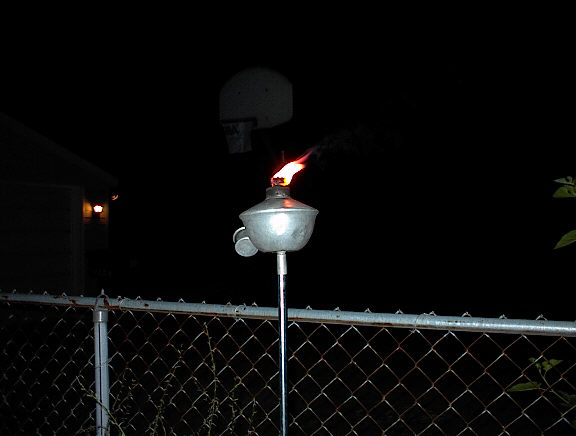
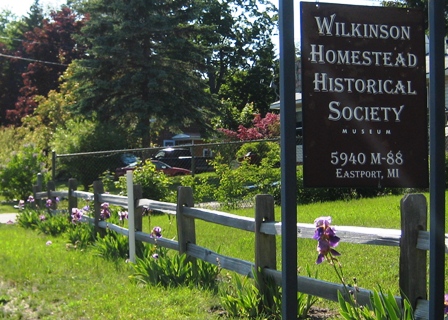
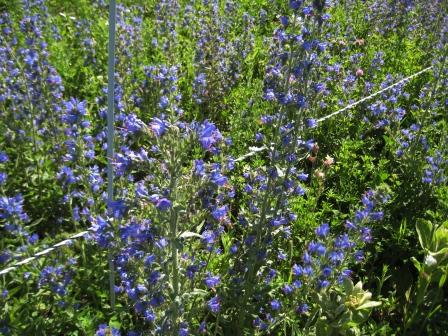
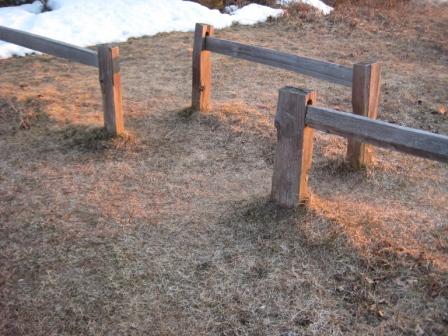
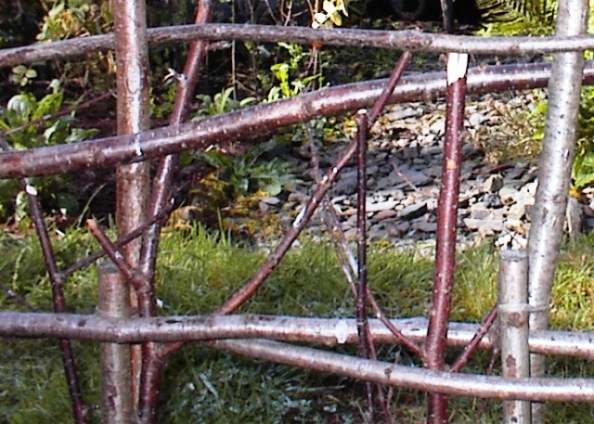
Anna Surface
January 7, 2010
Well now, this is a wonderful telling fence post…. uh, writing…. LOL Not wording this right, Gerry!
Long ago, when the weather would warm up, I remember leaning on the fence yakking with neighbors. Today is different. Last spring we, and I mean Preston and I all by ourselves, built a cedar fence around our property.
Fences…. I haven’t thought about writing about fences or even putting together something about the fences in our area. We have a thing for barbwire and stone fences. It is popular here in the rebuilding of the old stone fences. I have come across the electric fences in my photographic sojourneys yet I haven’t stumbled into one and received a jolt. Thank you for the ping! 🙂 Say, I really like the twig fence, and how nice to light torches along the fence.
Gerry
January 7, 2010
I think you could make quite an interesting series on fences, Anna. As I got to thinking about the subject, I was struck by the different angles, from art and architecture to the utterly pragmatic, with a large dose of history thrown in.
Cheri Sell
January 7, 2010
Your wall comment reminded me of John Lennon’s album, Walls and Bridges.
Gerry
January 7, 2010
You’ve put me in good company, ma’am. Thank you!
p.j. grath
January 8, 2010
Have you ever been to Zinzinnati? That town is full of beautiful stone walls and wrought-iron fences and stained-glass windows and fanlights. Hills, too. (You’re not the only one who can digress, Gerry.) Robert Frost’s poem about the wall came immediately to my mind as I was reading your descriptions of fences. Oh, oh, oh!!! My favorites: the “snake” fences of Manitoulin Island!
Gerry
January 8, 2010
I have been to the Queen City on its seven hills. I have very happy memories of the place and the love that brought me there. My, my.
I like snake fences, too, and could have sworn that there was one somewhere on Torch Lake Views. I rummaged around and didn’t find it, but maybe I’ll capture another on my rounds.
Cindy Lou
January 8, 2010
I used to try and get my little brother and small cousins to pee on the electric fences….always good to get a chance to get back at the annoying little boys! Of course, now as an adult – I feel bad about it……OK, not really! It still makes me smile 🙂
Gerry
January 8, 2010
Cindy Lou! You were a naughty little mite, weren’t you!
Fee
January 8, 2010
My fence is currently buried under snow, which means I can’t see that it needs painted. I still know it needs painted, I just can’t see it!
Gerry
January 8, 2010
I am in favor of a restful winter unburdened with the sight of undone chores. Fee, are you familiar with the story of Tom Sawyer and the painting of the fence?
Fee
January 9, 2010
I’m not, sorry. Blame the British education system!
Gerry
January 9, 2010
No reason you should be sorry. Mark Twain’s The Adventures of Tom Sawyer is one of those American classics. It’s about a boy living in a Mississippi River town in the mid-nineteenth century, before the Civil War. Tom is an engaging little miscreant, and one of the scenes that has made it into our cultural imagination has to do with whitewashing a fence. Tom dislikes the chore, but comes up with a scheme. He proceeds to paint as if he is enjoying it mightily. He examines his work with a critical eye. He adopts the pose that he is engaged in challenging and fulfilling work. A man’s work. Pretty soon he manages to persuade his friends that what he is doing is far more interesting than mere play. Eventually he gets them to pay him for the privilege of whitewashing the fence for him. You can see why the story has wide appeal.
Gerry
January 9, 2010
P.S. This is why you will occasionally see me gleefully proclaim that Thomasina Sawyer is relaxing in the shade while someone else (Babs or Katherine or the Weatherman, for example) writes the blog post of the day!
Fee
January 9, 2010
Mmmmm, might try that with the kids, come summer. They won’t have to pay me, though, that would be taking it a bit far!
Kathy
January 9, 2010
I am having weird thoughts rambling around in the head this morning. You know what I started thinking about when reading this? The fences that we humans put up on a psychological level. Keeping this person in and this person out. This can come in, but not this. How many fences do we have that we’re not even aware of? What do you think?
Gerry
January 9, 2010
I think we have many Invisible Fences that we misunderstand ourselves, and many fences that we think are invisible but that are perfectly apparent to the rest of the world. I think all fences make a statement, whether it be “I am responsible and keep my dogs in my yard” or “This is mine–keep out” or “You are invited to linger and enjoy this beautiful garden” or “Never you mind what’s back here.” I suspect the Lady Alicia, who is an accomplished architect, would argue that all built environments make a statement. I will have to ask her. I am positive that my cousin Craig would say that fences are pretty much like fashion, and that whether we will it or not, we are always saying something. This is why I think a person with an overactive imagination could make an interesting book about fences.